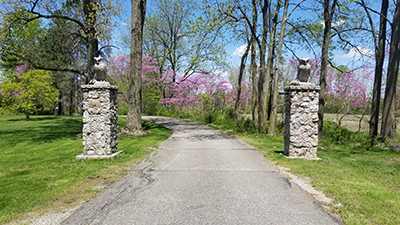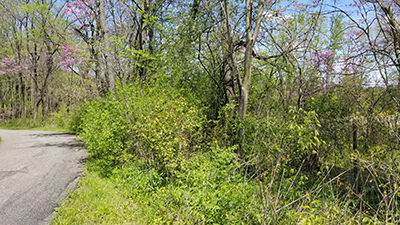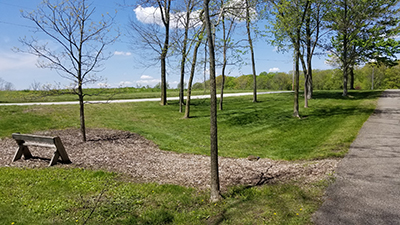Published May 4, 2020
Guest Blog: Invasive Plant Species – and what to do about them
By Tiffany Parker, site manager, Gene Stratton-Porter State Historic Site
Much of author and naturalist Gene Stratton-Porter’s gardening work can still be seen today at Gene Stratton-Porter State Historic Site in Rome City. Most of it – like all the beautiful large flowered trillium in bloom right now, and her stunning garden – brings beauty. But, some of her work didn’t prove to be as valuable long-term.
In fact, some of what she planted is considered harmful by today’s standards, because those choices introduced invasive species to the property.
Gene planted hedgerows to provide a little bit of privacy and create a habitat for birds. Little did she know at the time that both species would turn out to be incredibly aggressive invaders – ones that we still continue to battle today.

Glossy Buckthorn (Rhamnus frangula) and amur honeysuckle (Lonicera maackii) were both highly recommended during Gene’s time as hedgerows and cover for privacy due to their rapid growth. Gene planted both, but the invasive species have gradually begun to take over parts of the property throughout the years.
Although birds enjoy the delicious berries produced by both these plants, there is minimal nutritional value. We have been working slowly on control and eradication of invasive species at the Gene Stratton-Porter State Historic Site, and this is also an initiative taken up throughout Indiana.

Invasive species is a term that many conservation groups are familiar with, but it has become a bit of a buzz word recently. Groups like the Indiana Plant Society (INPS) and The Nature Conservancy (TNC) have been working toward better control of invasive species at the base level by working with nurseries and the landscape industry to limit sales of these plants. It’s now illegal to sell or trade any of the 44 invasive species listed in the Terrestrial Plant rule.
Invasive species found in Indiana are typically from Asia. Since Asia is very close to the same latitudinal range as Indiana, these species thrive here. Unfortunately, there are no native predators or plants that can keep them in check, so we find ourselves with a monoculture of one species that drives out the native plants and essentially throws that ecosystem out of balance.
Honeysuckle actually produces a chemical and releases it into the soil to keep growth down around it, much like black walnut trees. Between their interactions with the soil and their prolific seed production, the native plant biome needs all the assistance we can provide to keep things in check.
There are many ways we can work to eradicate these invasive pests, and one of the best ways is education. Look in your own yard or neighborhood to see if there are invasive species in your area. There are several resources available to find out what to keep and what needs to go.
Once you discover an invasive plant, it’s best to eliminate it as quickly as possible and ensure you follow up with keeping it gone. Some invasive species tend to try to return, so it usually takes a year or two to completely eliminate it.

If you are worried about leaving a hole in your landscaping, check the INPS website for a listing of great native plants and shrubs to replace it with. The great thing about native plants is that there is a good possibility the seed is in place, but it just needs the right opportunity to grow.
For more information on invasive species and the newly implemented Terrestrial Plant Rule limiting the sale & trade of 44 invasive species, please visit one of the websites below.
- Indiana Invasive Species Council: www.entm.purdue.edu/iisc/invasiveplants.php
- Indiana DNR: www.in.gov/dnr/naturepreserve/4736.htm
- Terrestrial Plant Rule: www.in.gov/dnr/6351.htm
- INPS: www.indiananativeplants.org/








